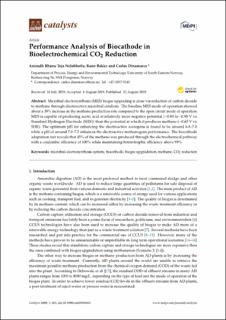Performance analysis of biocathode in bioelectrochemical CO2 reduction
Peer reviewed, Journal article
Published version
Permanent lenke
https://hdl.handle.net/11250/2650582Utgivelsesdato
2019Metadata
Vis full innførselSamlinger
Originalversjon
Nelabhotla, A. B. T., Bakke, R., & Dinamarca, C. (2019). Performance Analysis of Biocathode in Bioelectrochemical CO2 Reduction. Catalysts, 9(8), 683. 10.3390/catal9080683Sammendrag
Microbial electrosynthesis (MES) biogas upgrading is done via reduction of carbon dioxide to methane through electroactive microbial catalysis. The baseline MES mode of operation showed about a 39% increase in the methane production rate compared to the open circuit mode of operation. MES is capable of producing acetic acid at relatively more negative potential (−0.80 to –0.90 V vs. Standard Hydrogen Electrode (SHE)) than the potential at which it produces methane (−0.65 V vs. SHE). The optimum pH for enhancing the electroactive acetogens is found to be around 6.8–7.0 while a pH of around 7.0–7.5 enhances the electroactive methanogens performance. The biocathode adaptation test reveals that 45% of the methane was produced through the electrochemical pathway with a coulombic efficiency of 100% while maintaining heterotrophic efficiency above 99%.

